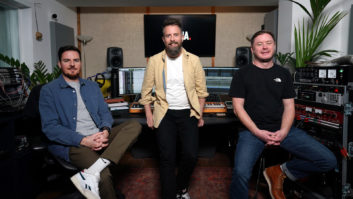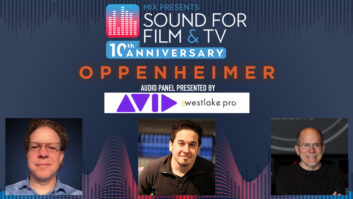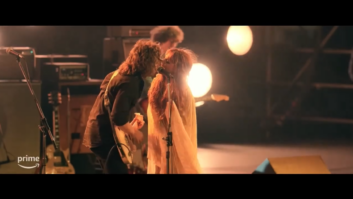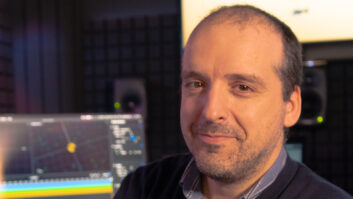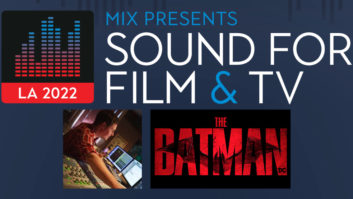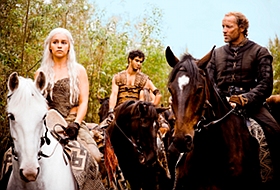
For scenes with actors talking while on horseback, production sound mixer Ronan Hill opted to go primarily with RF mics.
Photo: HBO/Heather Sloan
Game of ThronesHBO’s new 10-part series, Game of Thrones (starting April 17), is based on a best-selling series of American writer George R.R. Martin epic fantasy novels called A Song of Ice and Fire, of which A Game of Thrones is the first book. Four gargantuan tomes have been published since 1996, with three more promised, plus there are also prequels and many tangential products (games and such) already out there or to come.

Production sound mixer Ronan Hill mixes on a Cooper 208D, recording to a Sound Devices 788T.
Set in an undefined time that bears some similarities to Europe in the Middle Ages, but also has characteristics of other epochs and cultures, and elements that are pure fantasy, Game of Thrones is a dense and complex story. It’s set in the Seven Kingdoms of the Westeros, each ruled by a different “House,” each with its own history and complicated personal and historical entanglements. There’s a snowy land, a desert land, great fortresses, battles, betrayals, sex, court intrigue, dragon eggs and even some murderous undead—quite a spectacle.
Season One was shot in Northern Ireland and Malta (and for the pilot only, Morocco instead of Malta), using mostly little-known American, British and Irish actors. The 21-week shooting schedule for the 10 episodes was fast-paced and intense, as the action moved between numerous outdoor locations around Northern Ireland and to sets built on a huge soundstage complex in Belfast known as the Paint Hall, which at one time was part of the Harland & Wolff Shipyards where the Titanic and many other ships were built.
“The Paint Hall is this aircraft hangar–sized building with four cells [each 16,000 square feet] for constructing sets, but it was purpose-built to paint ships and not for recording sound,” says production sound mixer Ronan Hill, himself a Belfast resident. “It’s got metal walls, and I think we initially reckoned it had about a 4-second reverb time, so right away that is something you have to plan for. We have a lot of large sets, and the nature of this period [in the story] means there are no glazed windows, so things are opened into the void. And the nature of lighting is they like to have the option of lighting from above so they’re not necessarily enclosed at the top either. So it’s shaping up very nicely, sound-wise, as you can see. [Laughs] Then you’re also dealing with special effects with fans to make whatever’s supposed to be outside the windows move, and all the other issues.
“Hopefully, for Season Two, if it gets green-lit, they’ll continue making progress in trying to improve the four existing cells, and they’re also building another two stages at the Paint Hall location,” Hill continues. “But even with the challenges, it worked out fine and it was nice to have some respite from going in the elements.”
Much of the series was shot outdoors in sometimes remote locations—always a challenge for production mixers. “We’ve been on locations that are right on top of a mountain where it means getting up very early, cross-loading onto four-wheel-drive trucks, getting up to the top of the mountain and being up there for the day to work,” Hill says. “For that one on the mountain, we drove an hour-and-a-half [out of Belfast] to get there and then it’s half-an-hour up the mountain, so it’s a very long day. But it was beautiful and isolated. The flip side of that is they’ll find another location in woods beside a main road, on a flight path. Those are situations where you might go more heavily into radios [RF mics]. You’re trying to get the mics more isolation so you can keep the background out as much as possible and hopefully they can also take a little bit more out of it in post if possible.
Hill has primarily worked on various UK television series (Bel’s Boys, The Invisibles) and independent films (Five Minutes of Heaven, Hunger, The Eclipse—all critically acclaimed) over the course of a career that goes back to the mid-’90s. During that time, his production sound rig has evolved from stereo DAT to an 8-channel digital recorder and 8-channel mixer. “The mixer I’m using is a Cooper 208D, which is really my favorite piece of kit,” he says. “[The show is] recorded onto a Sound Devices 788T 8-track, which is also a great machine. Before that, I had a 744, and actually I still keep that on my cart as a backup machine.

Photo: HBO/Heather Sloan
“One thing I would love Sound Devices to do,” he adds, “is they have eight analog inputs on the side of the 788 and eight digital inputs on the back of it, but you are unable to use a full combination if you like. You are able to use the eight analog inputs and even two digital inputs as isolated tracks, but on something like Game of Thrones, where you’re up in characters all the time—I think we had 14 speaking characters in one scene—it would be great to have even more flexibility with inputs. Due to the nature of being either outside somewhere remote or inside somewhere that isn’t always sound-friendly, you tend to be wiring people up constantly to cover everything you need.”

Photo: HBO/Heather Sloan
Hill will usually run two booms on a scene, if possible—his mics of choice there are Sennheiser MKH 60 or MKH 70 shotguns for outside work; for inside, an MKH 50 or a couple of the newer versions in that line, the MKH 8040 or 8050. As for RFs, “Before I started Game of Thrones, I replaced my long-serving Audio Ltd. 2020 radio mics with new UK spectrum-channel 32 2040 models. I have six belt pack transmitters and two mini-transmitters that are smaller and very discreet. The beltpacks are very good and very versatile in that, if you need to, you can buy a lead off Audio Ltd., plug it in and it will phantom-power any mic, so that’s great. Audio Ltd. also makes the RK6, which is a rack that takes six receivers, and the RK3, which is a little portable rack that takes three. So for my portable kit, I have two RK3s strapped together, and that allows my RK6 to stay on the cart. I can connect all racks together to allow up to 12 channels from two antennae. Believe it or not, in 21 weeks I only went portable once, but I’ve used it more on other [projects].”
The production mixer’s job is a never-ending series of calculations and accommodations to get the best possible sound for a scene. One complicating factor is the now-common practice of using two cameras at once, which can affect boom placement and the overall sonic perspective. Clothing in a series like this can also pose challenges for RF mics “because of all the leather and the chain mail, which can be quite noisy,” Hill says. “Also, larger numbers of people in a larger environment can be hard. In Episode One, we had a three-page scene where we had seven people talking right beside a river. They all have one line each and by the time you get the fader up on the first guy, the next guy is talking, so you have to be very fast. There are scenes where there might be music being played—drummers and such—and you have to plan for that, and also a lot of fast-paced exteriors, with people talking on horseback; that gets pretty tricky, as well. Obviously, you’re going to go radio on that.”
And then, of course, there’s weather: “We were shooting September to December, so you’re getting into -10, -15 [Celsius; that’s 15 and 5 degrees Fahrenheit, respectively]. We had quite a cold snap and also quite a lot of rain. It didn’t really pose any problems for me other than the discomfort. In any case, you do the best you can in the situation you’re in, give them as much as you can to play with, and then whatever you can’t manage due to environmental circumstances or the nature of what you’re doing, you know they’re going to do a good job on it in post.”
How does Hill deliver his tracks to post? “Normally, the first two tracks would be two booms—what’s on camera would be the first boom and what’s off would be the second boom,” he says. “I think that’s more of a European way rather than an American way, where I gather post generally likes everything on one track. What I did on this job, because I still want the boom to be what they’re listening to first, is the main boom still goes on the first track, but then I was giving them a radio mix on the second track and then isolated [radio] tracks with second boom after that. That allows them to be able to tweak between the radio mix with a little bit of boom, or if the radio mixes are noisy, they can fade the boom up and have a little bit more of it. That’s the best way to give them something they can listen to quickly, and that should be enough to get them to the next stage with it.”
Hill is constantly backing up his work over the course of a day—the Sound Devices 788T has both an internal SATA hard drive and a CompactFlash, which Hill uses with a FireWire 800 port. “I tend to back up rushes off the hard drive onto the daily CompactFlash, so at least you’re always running two recordings in the one machine, if you like. If one goes down, you still have the other one.”
Posting for the series (still underway at press time) has been at Screen Scene in Dublin. Meanwhile, Hill has gone on to other projects, but is awaiting word on whether there will be a Season Two of the HBO series, which has been a tremendous creative endeavor for him, provided steady work and has been close to home: “One of the good things about this job and being based in Belfast is that even though the day may be long, getting into 15 or 16 hours, you’re still getting home every night.”

